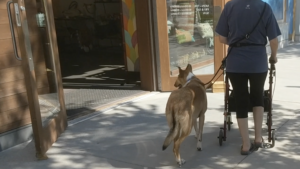Creak! What’s behind the door? Doors can be scary. In horror movies they are often opened slowly, in anticipation of a monster is on the other side. For dogs, doors can hold a lot of excitement, surprises and also possibly be scary.
Service dogs need to be very comfortable with doors and doorways. They need to confidently enter doors that lead to a wide variety of situations. Manual doors, automatic doors and in some cases the service dog may be needed to help open the door.
Helping a dog become comfortable entering and exiting various doorways in many different types of situations involves more than just exposure. It also requires carefully setting up situations at a level that the dog can build confidence. Simply exposing the dog to lots of doorways without considering the individual dog risks exacerbating fears. Pet owners and service dog handlers alike often overlook the fact that their dog is nervous around a doorway. They misinterpret the dog’s willingness to enter as meaning that the dog is completely fine.
A dog bolting through a door is often interpreted by owners as the dog being enthusiastic to enter the space. If the dog is off leash and being let out into a yard the dog probably is simply excited. However, I find that in many other contexts bolting through doors often indicates that the dog is conflicted (both excited and worried) or nervous about the doorway or the situation. Dogs may bolt through a door because they are afraid of the doorway and trying to avoid spending time in that area. Subtle indications of fear or stress such as the dog briefly lowering his or her head to smell as the dog enters are often completely missed by handlers. Negotiating doorways requires extra attention for people with mobility or sensory impairments and a handler with a disability may not see the dog’s stress signs.
So how to build confidence for service dog candidates worried about doorways? Well first, a big picture approach can help. Consider the dog’s age. Many times for younger dogs, simply avoiding the fearful situation for a few weeks can help. Adolescent and younger dogs can go through fear or sensitive periods and may simply need a little time to mature.
If the fear continues over time, confidence building activities may be useful. It is not uncommon for dogs to be concerned about the environment and situation, not just the door. Taking a step back and working the dog in easier, less complex settings can help shed light on exactly what the dog’s fears are and help the dog build confidence. Games, acting “silly” and low-pressure trick training can help as well.
In some cases it may help to create door-like experiences in a context the dog is already very confident in. Agility tunnels, ring gates or chairs draped with towels can be used to create unusual entrances. Clicker training strategies like shaping, targeting or play activities with toys the dog already loves can all be used to create a new association with entering doorways. Any activity that can help build confidence may be helpful here for instance, outdoor hiking and climbing on logs or exploring rocks can help the dog learn the world is an interesting, fun and safe place and may indirectly help the dog become more confident in doorways as well.
When revisiting a new door with a dog that is young or unsure, I like to use a circling approach. We approach the door and then move away from the door in a large circle. We repeat this a few times then leave the area for a “sniff break,” an unstructured opportunity for the dog to sniff and explore a patch of grass or tree. We return after a few minutes and repeat the circles. If the dog appears to be increasing in confidence, we continue, allowing the dog to look at the entrance but then move away and then finally entering if the dog seems ready. Using video to document can help owners learn to see signs of stress they may have missed.
For young dogs, keeping the experience short and sweet is key. A scary or overwhelming experience after entering a door could exacerbate the issue. Last but not least, having a confident and experienced “helper” dog to enter the door first can help a lot in some cases.
Happy Training!

